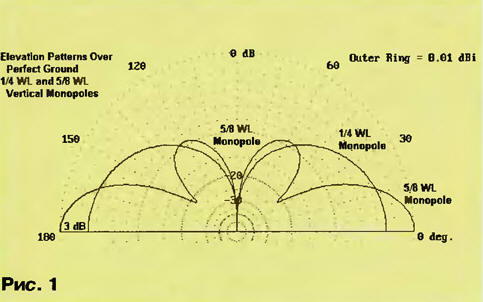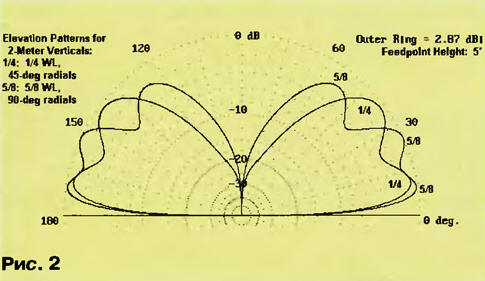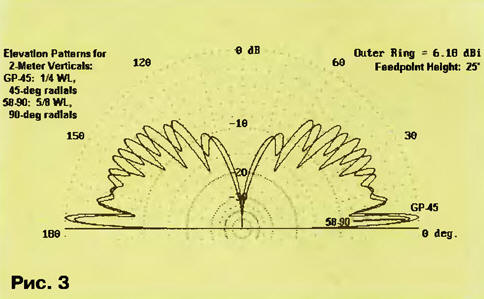Article V. Polyakov (RA3AAE) "antenna "five eighth lambda", published in "Radio", 2000, № 4, p. 66, 67, spoke out and argued position that the vertical antenna length 5λ/8 is not optimal emitter on УSW and high frequency LW ranges.
Thus, a widespread belief that this antenna provides the highest the win gives the maximum pressed to the ground the main lobe of the chart orientation (LTO), is true only for mediumwave antenna, installed directly on a well conducting ground (Fig. 1). Actually, this antenna and was designed by S. Ballantine as antifading medium wave, debilitating ionospheric wave at such angles for which there is a the interference surface and ionospheric waves.

American radio Amateur W4RNL <http://wvwv.cebik.com/58.html> modeled on computer various antennas, including 5λ/8. Here is what is interesting conclusions that prove this, he came.
Vertical band antenna 80 meters buried in the ground counterweights provide small angles of radiation to the horizon and are particularly suitable for distant relations. W4RNL reports that the antenna height 5λ/8 has the advantage over antenna λ/4 only the poor and very poor soil conductivity lower than 2 MS/m, moreover, the gain is much less than the promised 3 dB (Fig. 1). Given that set the mast height of 50 m is not so easy, "game were" hardly worth it "dressing".
In the range of 2 meters at low altitudes, which is typical when working portable radio stations, the main lobe of any antenna much "lifted up" into the sky, and in these conditions antenna 5λ/8 is slightly better quarter-wave pin. The directivity of these antennas in a vertical plane when placing power point at a height of about 1.5 m above ground are shown in Fig. 2.

Radial elements of a quarter-wave antenna is positioned at a 45° angle to the horizon, and the radials of the antenna length 5X/8 - in horizontal plane.
In the same range of 2 meters when the height of the suspension (h>λ) antenna length 5λ/8 turned out to be no better than conventional quarter-wave pin with inclined quarter-wave counterweight, the latter even had a small advantage! Besides it is easier is consistent with the feeder. Pattern antennas at the height of the point of power over the earth 7.5 m shown in Fig. 3.

"Brokenness" of these multileaf charts is explained by the interference of direct and reflected from the earth waves.
Author: W4RNL






